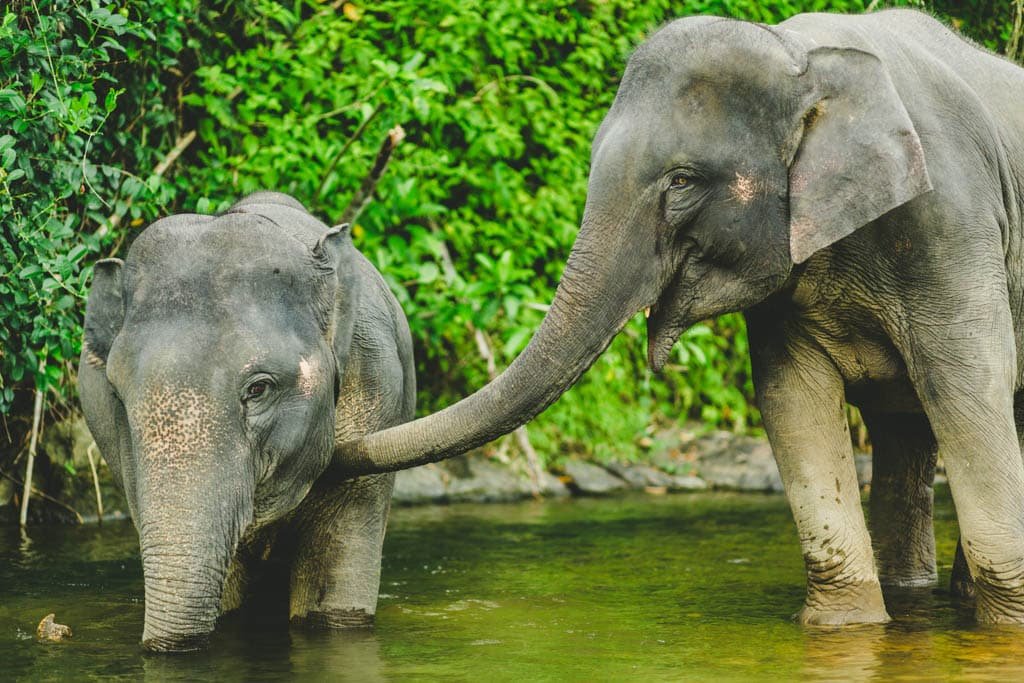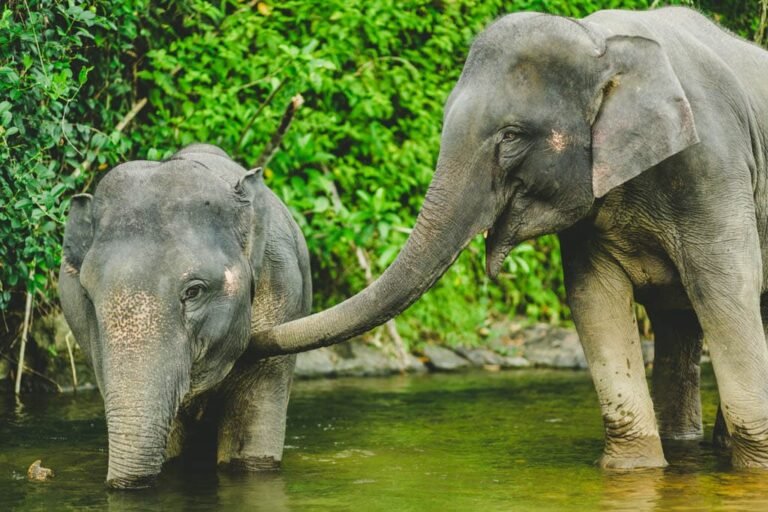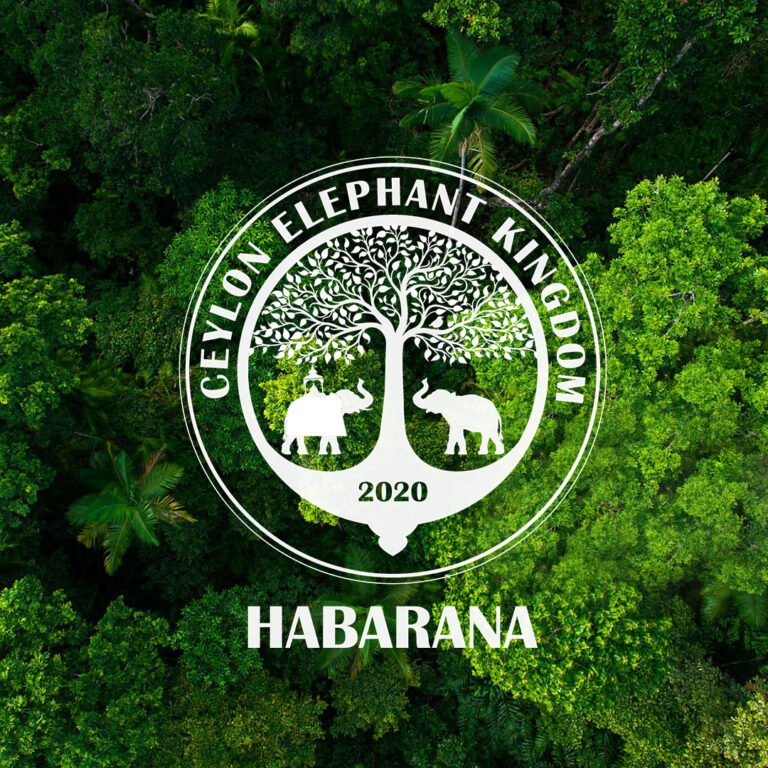Ceylon Elephant Kingdom
Ceylon Elephant Kingdom

Discover the Ceylon Elephant Kingdom: A Sanctuary in Habarana, Sri Lanka
Tucked away in the heart of Sri Lanka’s cultural triangle, the Ceylon Elephant Kingdom in Habarana offers visitors an incredible opportunity to connect with the island’s majestic tamed elephants in a safe and ethical environment. Known for its commitment to elephant welfare, this sanctuary provides a unique experience for travelers eager to witness these magnificent creatures up close while contributing to their conservation.
Sri Lanka has a long history of reverence for elephants, with these gentle giants playing an important role in the island’s culture, religion, and natural heritage. Unfortunately, elephants often face threats from poaching, habitat loss, and exploitation for tourism. The Ceylon Elephant Kingdom stands apart from other wildlife attractions by offering a sanctuary where elephants can live freely and be treated with the respect and care they deserve.
Whether you’re an animal lover, a wildlife enthusiast, or simply looking for an unforgettable adventure, a visit to the Ceylon Elephant Kingdom is an experience that will leave you with a deeper appreciation for these awe-inspiring creatures and the efforts made to protect them.
Location and Overview
Located in the north central province of Sri Lanka, Habarana serves as a gateway to the country’s iconic cultural sites, such as Sigiriya and Polonnaruwa. The Ceylon Elephant Kingdom is situated in a picturesque rural setting, surrounded by lush greenery and serene landscapes, making it the perfect retreat for those looking to explore the island’s natural beauty while getting closer to its wildlife. With easy access from major tourist hubs like Kandy and Dambulla, it’s a must-see destination for travelers seeking an authentic wildlife experience.
The Ceylon Elephant Kingdom is dedicated to the care and conservation of tamed elephants, providing them with a safe haven where they can roam freely, interact with visitors, and receive the care they need to thrive. Unlike other elephant centers that may focus on performances or rides, the Kingdom emphasizes the importance of ethical treatment, ensuring the well-being of the elephants above all else.
The Elephants and Their Story
The elephants at the Ceylon Elephant Kingdom are not just animals on display—they are part of a larger conservation effort. Many of the elephants housed here have been rescued from difficult circumstances, including captivity, exploitation, and the illegal pet trade. They have found refuge in this sanctuary where they are free to live out their days in a more natural environment.
Each elephant has its own unique story. Some were once forced to work in logging or parades, while others were kept in confined spaces for entertainment purposes. Today, they are allowed to roam the sanctuary’s expansive grounds, forming bonds with their fellow elephants and the dedicated caretakers who tend to them.
Visitors have the chance to learn about these individual stories, which adds a personal touch to the experience. It’s not just about observing the elephants; it’s about understanding their past and the ongoing efforts to provide them with a better future.
Ethical Interaction with Elephants
One of the most notable aspects of the Ceylon Elephant Kingdom is its commitment to ethical wildlife tourism. Unlike other elephant attractions that might encourage activities like elephant rides or circus performances, the Kingdom focuses on responsible interactions that prioritize the well-being of the elephants.
Visitors can engage in activities such as feeding the elephants, walking with them through the jungle, or helping bathe them in the nearby river. These activities allow tourists to connect with the elephants on a deeper level, while also ensuring that the elephants’ natural behaviors are respected. The Kingdom does not support activities that may cause distress to the elephants, such as performing tricks or forcing them into unnatural situations.
This ethical approach provides a more authentic, meaningful experience, where the elephants’ comfort and safety are always the top priority.
Activities and Experiences
The Ceylon Elephant Kingdom offers a variety of engaging activities that allow visitors to interact with the elephants in a safe and respectful manner. Some of the highlights include:
- Feeding the Elephants: Guests can offer bananas and other treats to the elephants, creating a bonding experience that brings visitors and elephants together.
- Bathing and Washing Elephants: Taking part in the ritual of bathing elephants in the river is a favorite activity. It’s not only fun for visitors, but also a refreshing experience for the elephants.
- Walking with the Elephants: Visitors can accompany the elephants as they take leisurely walks through the sanctuary’s forested trails, providing a unique opportunity to observe these magnificent creatures in their natural habitat.
- Learning about Elephant Conservation: Knowledgeable guides share important insights about the elephants’ biology, history, and the conservation efforts in place to protect them. This is an educational experience, helping guests understand the significant role elephants play in Sri Lanka’s ecosystem.
These activities allow visitors to form a deep connection with the elephants while supporting their conservation and well-being.
The Role of the Ceylon Elephant Kingdom in Conservation
Beyond offering a sanctuary for elephants, the Ceylon Elephant Kingdom is actively involved in broader elephant conservation efforts in Sri Lanka. The Kingdom helps to raise awareness about the challenges elephants face in the wild, such as habitat loss, human-elephant conflict, and poaching.Main thing is elephant conservation to next generation
Through educational programs and partnerships with wildlife organizations, the Kingdom plays an important role in educating both locals and tourists about the importance of protecting elephants. Additionally, the sanctuary’s commitment to ethical tourism helps to set a positive example for responsible wildlife experiences across the country.
The Kingdom also works to preserve Sri Lanka’s natural ecosystems, ensuring that elephants have access to the safe, thriving habitats they need to survive. By supporting sustainable practices and providing a sanctuary for rescued elephants, the Kingdom contributes to the long-term survival of the species.
Conclusion
A visit to the Ceylon Elephant Kingdom in Habarana is more than just an opportunity to see elephants up close—it’s a chance to learn about and support the conservation of one of the world’s most majestic species. Through ethical interactions, a focus on elephant welfare, and engaging activities, the Kingdom offers a unique and meaningful wildlife experience that visitors won’t soon forget.
Whether you’re traveling to Sri Lanka for the first time or returning to explore its cultural wonders, the Ceylon Elephant Kingdom is a must-visit destination for anyone who cares about wildlife and wants to make a positive impact on conservation.
Call to Action
If you’re planning your next adventure to Sri Lanka, don’t miss the chance to visit the Ceylon Elephant Kingdom in Habarana. Connect with these incredible creatures, support their conservation, and leave with a deeper appreciation for Sri Lanka’s elephants. Share this blog post to help raise awareness about this ethical sanctuary and inspire others to visit and support responsible wildlife tourism!
Ceylon Elephant Kingdom
Introduction to the project
Why is this project needed and how does it become sustainable?
The “Elephant Village” project in Kandalama, Sri Lanka, aims to address the critical issues surrounding the management of Asian-tamed elephants while also promoting sustainability. Here’s why this project is needed and how it aims to achieve sustainability:
Holistic approach
The Elephant Village project adopts a comprehensive and holistic approach to achieve its goals.That spans across various dimensions to ensure its effectiveness and longevity:
Conservation of Asian Tamed Elephants and Habitat Preservation:
Asian tamed elephants (Elephas maximus) are an important cultural and historical symbol in many Asian countries, including Sri Lanka. However, these elephants often face challenges related to habitat loss, human-elephant conflict, and unsustainable management practices. The project recognizes the need to conserve and protect these elephants to ensure their survival for future generations. At its core, the project is committed to conserving the Asian tamed elephants and their natural habitat. By restoring and protecting their ecosystems, the project not only safeguards these elephants but also supports the broader biodiversity and ecological balance of the region. Through particular care, including proper veterinary attention, balanced. nutrition, and naturalistic living conditions, the project ensures the well-being of the elephants.
Human-Elephant Conflict Mitigation:
Sri Lanka experiences frequent human-elephant conflicts due to the shrinking natural habitats of elephants and the violation of human settlements into their territories. The Elephant Village project likely focuses on finding sustainable ways to reduce such conflicts, which can involve creating buffer zones, employing advanced monitoring and tracking technologies, and implementing community- based solutions. The project aims to mitigate human-elephant conflicts through community engagement. It involves collaborating with local communities to develop strategies that enable peaceful coexistence. By minimizing conflicts, both humans and elephants can thrive harmoniously.
Tourism and Economic Benefit:
Tamed elephants have historically been used for cultural practices and religious festivals in Sri Lanka. The project could explore how sustainable elephant-related tourism can provide economic benefits to local communities while ensuring the welfare of the animals. This could involve responsible ecotourism practices, such as guided tours that educate visitors about elephants, their natural habitat, and the importance of conservation.
Research and Education:
The project may emphasize research on elephant behaviour, biology, and ecology. Understanding these aspects is crucial for developing effective
conservation strategies. This knowledge helps design effective conservation strategies and
allows for continuous adaptation based on scientific findings. Additionally, educating local communities, tourists, and stakeholders, local schools about the importance of elephant conservation can help foster a sense of responsibility towards these animals and to install a deep understanding of the importance of these animals to the ecosystem. Raising awareness and understanding about elephants and their conservation needs contributes to sustainable practices. By generating valuable insights, the project adapts its strategies for optimal impact. Concurrently, educational programmes distribute knowledge about elephants, their importance, and the significance of coexistence with them.
Health and Welfare of Elephants:
A critical aspect of the project is likely to focus on the well-being of the elephants. This includes ensuring proper veterinary care, nutrition, and living conditions for the tamed elephants. Sustainable management involves creating environments that closely mimic their natural habitats and catering to their physical and psychological needs. By ensuring the physical and psychological health of the elephants, the project contributes to their long-term sustainability.
Achieving Sustainability:
The Elephant Village project can become sustainable through various strategies: Community Engagement: Involving local communities in decision-making processes can lead to a sense of ownership and responsibility. This can include providing alternative livelihoods, empowering communities to participate in conservation efforts, and raising awareness about the importance of coexisting with elephants.
Eco-Friendly Infrastructure/ Environmental Sustainability:
The project can be designed with eco-friendly infrastructure that minimizes its impact on the environment. This includes using renewable energy sources, efficient waste management systems, and environmentally conscious construction practices to minimize its environmental footprint. By reducing its ecological footprint, the project showcases a commitment to the well-being of both elephants and the planet. This commitment to sustainable infrastructure aligns with global efforts to mitigate climate change and reduce resource consumption.
Responsible Tourism:
If tourism is a component of the project, it’s crucial to ensure that tourism practices are responsible and ethical. This involves limiting the number of visitors, providing educational programmes, and minimizing disturbances to the elephants and their habitats. By recognizing the potential of elephant-related tourism, the project introduces sustainable tourism practices that respect the animals’ well-being and their environment. Tourists are educated about the significance of elephant conservation, fostering a sense of responsibility and respect. The project incorporates responsible and ethical tourism practices. Guided tours, interactive learning experiences, and cultural exchanges provide visitors with opportunities to appreciate the elephants while contributing to their conservation. Tourism revenues directly benefit the project and local economies.
Research and Monitoring:
Continuously gathering data on elephant populations, behaviour, and habitat conditions will help make informed decisions for their conservation. Monitoring their well-being and implementing improvements based on research findings is essential for their sustainability.
Partnerships and Funding:
Collaborating with governmental and non-governmental organizations, as well as seeking sustainable funding sources, can provide the project with the resources needed for long-term success.
Sustainable Livelihoods / Economic Empowerment:
The project supports local communities by providing alternative livelihood opportunities, such as involvement in ecotourism, handicrafts, and other sustainable activities. By diversifying income sources, the project reduces dependency on practices that may negatively impact elephants or their habitats. This approach reduces dependency on activities that might negatively impact elephants and their habitats.
In conclusion, the Elephant Village project in Kandalama, Sri Lanka, is needed to address the conservation and management challenges facing Asian-tamed elephants. Its sustainability is achieved through a holistic approach that includes community involvement, responsible tourism, research, and a commitment to the health and well-being of the elephants. By aligning with the Sustainable Development Goals, it aspires to create a model that ensures the well-being of elephants, local communities, and the environment, serving as an inspiration for similar initiatives worldwide.
First-ever initiative in Sri Lanka
The Elephant Village project is pioneering, marking the Sri Lanka’s first concentrated effort to comprehensively address the ethical and sustainable management of Asian tamed elephants. By demonstrating innovative strategies, it sets a precedent for similar initiatives globally, inspiring other regions to adopt similar approaches to elephant conservation and management, offering a blueprint for conservation, community engagement, and responsible tourism. By intertwining conservation, community engagement, responsible tourism, research, and environmental consciousness, the project serves as a global model for aligning with Sustainable Development Goals while preserving a vital piece of cultural heritage.
This project represents a pioneering and essential initiative aimed at establishing a sustainable model for the management of Asian tamed elephants. The project is motivated by several critical factors:
Conservation of Cultural Heritage and Biodiversity: Asian tamed elephants hold immense cultural and historical significance in Sri Lanka and other Asian countries. However, these majestic creatures face numerous challenges, including habitat loss, human-elephant conflict, and unsustainable management practices. The project recognizes the need to preserve this. cultural heritage while safeguarding the biodiversity and ecological balance of the region.
uman-Elephant Conflict Mitigation: As human settlements expand into natural habitats, conflicts between humans and elephants escalate. Such conflicts result in human casualties, property damage, and harm to elephants. The Elephant Village project seeks to address this issue by implementing sustainable strategies that minimize conflicts and promote peaceful coexistence.
Economic and Ecotourism Opportunities: By developing responsible and ethical elephant- related tourism, the project aims to create economic opportunities for local communities. This can simultaneously generate income while raising awareness about elephant conservation. This approach ensures that economic growth is aligned with environmental and social well- being.
The Elephant Village project in Habarana, Sri Lanka, represents a ground-breaking initiative aimed at addressing the complex challenges associated with the management of Asian tamed elephants. These majestic creatures, deeply woven into the cultural fabric of the region, face numerous threats, including habitat loss, human-elephant conflict, and unsustainable practices. The project’s significance lies in its multifaceted approach to ensure the welfare of the elephants, foster local livelihoods, and promote conservation, all while aligning with the principles of sustainability.
A project aligned with Sustainable Development Goals (SDGs): People, Planet and Profit
The Elephant Village project stands in alignment with the three pillars of sustainable development:
- . People: By empowering local communities, the project promotes social inclusion, alternative livelihoods, and capacity building. It addresses human-elephant conflicts, fostering peaceful coexistence and enhancing the quality of life for both residents and visitors.
- Planet: Through its eco-conscious practices, the project showcases its dedication to environmental stewardship. By minimizing resource consumption and promoting sustainable infrastructure, it contributes to the protection of ecosystems and biodiversity.
- Profit: The project’s sustainable tourism approach generates revenue streams that benefit both conservation efforts and local economies. The economic viability of the project ensures its long-term success and ability to create positive impacts
This project is fundamentally aligned with the United Nations’ Sustainable Development Goals (SDGs). It touches upon key aspects of the SDGs, including:
SDG 1 (No Poverty) and SDG 8 (Decent Work and Economic Growth): By creating sustainable livelihoods through responsible tourism, the project contributes to poverty reduction and economic growth. The project’s economic empowerment initiatives uplift local communities, reducing poverty and creating opportunities for sustainable livelihoods.
SDG 4: Quality Education: By educating communities and visitors about elephant conservation, the project promotes quality education and raises awareness about the importance of preserving natural heritage.
SDG 11: Sustainable Cities and Communities: Through its human-elephant conflict mitigation strategies, the project fosters safer and more sustainable communities, where humans and elephants coexist peacefully.
SDG 12: Responsible Consumption and Production: The project’s emphasis on responsible tourism encourages sustainable consumption practices while minimizing negative impacts on the environment and wildlife.
SDG 15: Life on Land: The project directly contributes to conserving terrestrial ecosystems and ensuring the sustainable use of land resources, safeguarding the diverse flora and fauna that inhabit them including tamed elephants.
SDG 17 (Partnerships for the Goals): The project’s collaborative approach, involving local communities, organizations, and stakeholders, exemplifies the importance of partnerships in achieving sustainable development.
Components of the project
1.Elephant conservation for the next generation
- Focuses on ensuring the survival and well-being of Asian tamed elephants for future generations.
- Involves habitat protection, anti-poaching efforts, and measures to respond the declining elephant populations.
2. Cultural preservation (Cultural Background (Procession concepts/ Dress patterns, Mahout and their sub-culture)
- Highlights the significance of elephants in various Asian cultures.
- Explores procession concepts, traditional dress patterns, and rituals involving elephants.
- Recognizes the important role of mahouts and their sub-cultures in elephant care
3. Interpretation and awareness
- Establishes a museum dedicated to promoting understanding and appreciation of elephants and their cultural importance.
- Offers educational programmes, exhibits, and interactive displays to raise awareness about elephant conservation.
4. Medical Treatments and Elephant Hospital (Veterinary facilities/ surgeons)
- . Provides comprehensive veterinary facilities and skilled surgeons specialized in elephant care.
- . Focuses on preventive healthcare, medical treatments, and emergency services for elephants.
5. Training Programmes & Certification for Mahouts
- Develops structured training programmes for mahouts (elephant keepers) to enhance their knowledge and skills in elephant care.
- Offers certifications to ensure responsible and ethical elephant management.
6. Research and Development (R&D)
- Supports ongoing research to better understand elephant behaviour, biology, and health.
- Aims to improve management practices based on scientific findings.
7. Breeding
- Implements a controlled breeding programme to maintain genetic diversity and increase the captive elephant population.
- Ensures the well-being of mother elephants and their calves.
8. Eco-friendly products (Elephant dung). Elephant based souvenirs/Recycling methods
- Utilizes elephant dung for creating organic and sustainable products.
- Develops elephant-based souvenirs to generate income for conservation efforts.
- Promotes recycling methods to minimize waste.
9.Organic Agriculture
Encourages organic farming practices to provide elephants with nutritious food and reduce the environmental impact of agriculture.
10. Managing Human Elephant Conflict
- Addresses conflicts between elephants and human populations, often arising due to habitat encroachment.
- Implements strategies to minimize negative interactions and protect both human and elephant lives.
11. Tourism – Elephant-based activities/ Elephant caring & feeding. Accommodation, Interpretation)
- Offers responsible and ethical elephant-based tourism activities that prioritize the well-being of elephants.
- Provides accommodations for tourists interested in experiencing elephant-related activities.
- Educates tourists and visitors about elephant behaviour, conservation efforts, and the importance of sustainable practices.
The holistic approach of this model project combines various elements to ensure the sustainable management of Asian-tamed elephants. It takes into account not only the physical well-being of the elephants but also their cultural significance, the importance of awareness and education, and the overall ecosystem in which they exist. The project aims to create a harmonious coexistence between elephants, humans, and the environment while fostering a sense of responsibility and stewardship towards these magnificent creatures.







